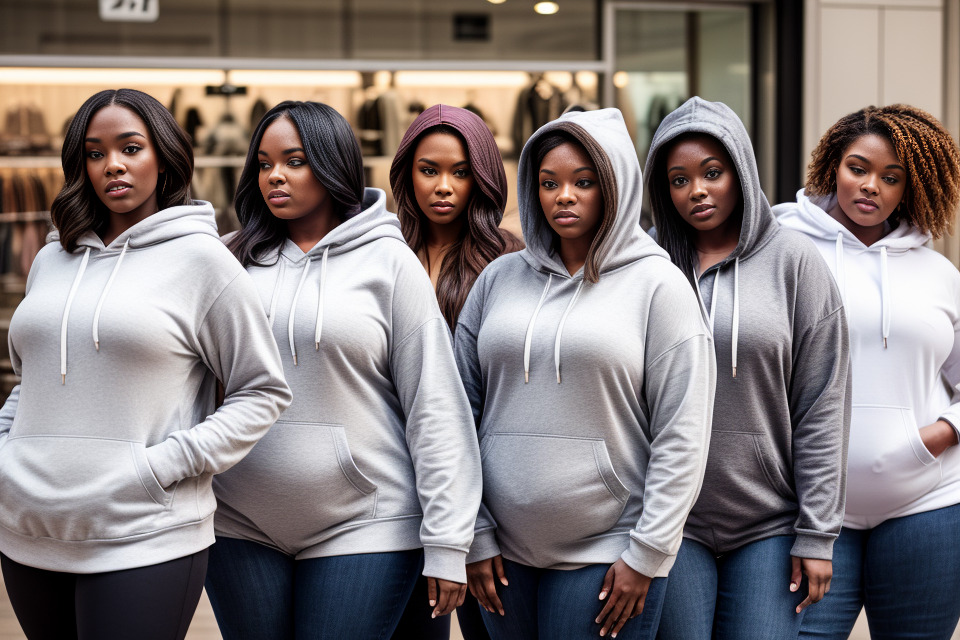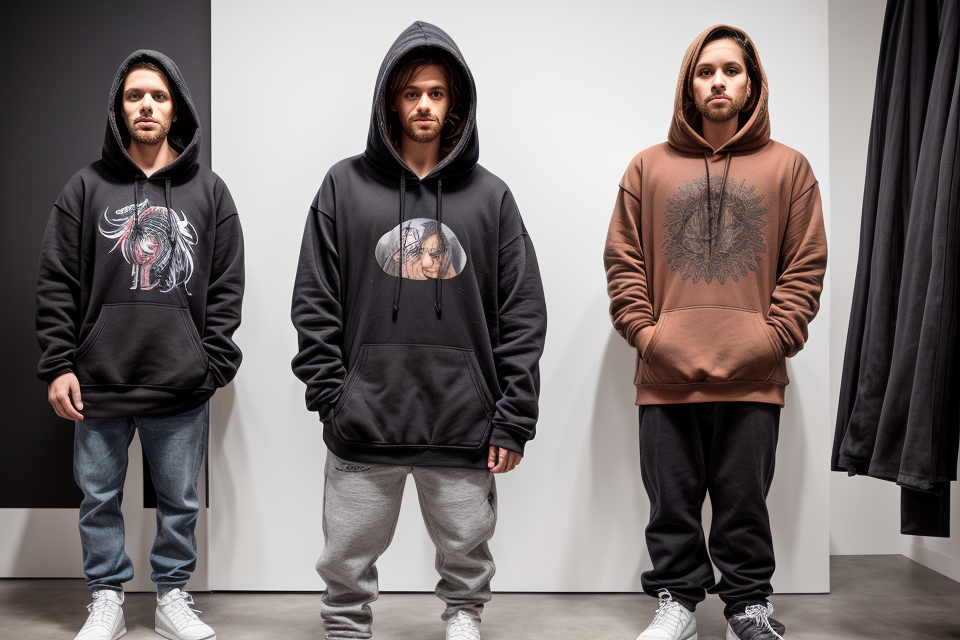
The debate on whether a hoodie can be considered professional attire has been a topic of discussion for quite some time now. Some argue that it’s a casual and comfortable piece of clothing that shouldn’t be worn in professional settings, while others believe that it can be dressed up or down depending on the occasion. In this comprehensive guide, we will explore the different perspectives on this topic and provide you with all the information you need to make an informed decision. So, whether you’re a hoodie lover or a critic, read on to find out more about this fashion staple and its place in the professional world.
What is Considered Professional Attire?
Different Industries and Their Dress Codes
Professional attire refers to clothing that is appropriate for work or business settings. The specific dress code for each industry can vary, with some industries having strict rules regarding what is considered appropriate attire. In this section, we will explore the different industries and their respective dress codes.
Business and Finance
In the business and finance industries, professional attire is typically formal and conservative. Men typically wear suits, dress shirts, dress pants, and dress shoes. Women often wear suits, dresses, or blouses paired with skirts or slacks. Accessories such as jewelry and watches should be minimal and understated.
Technology
In the technology industry, the dress code is often more casual than in traditional business settings. While jeans and t-shirts are common, it is still important to maintain a professional appearance. A nice pair of dress pants or khakis paired with a button-down shirt or a polo shirt would be considered appropriate. Avoid wearing t-shirts with offensive or inappropriate messages or graphics.
Healthcare
In the healthcare industry, the dress code is often more formal than in other industries. White coats are standard issue for medical professionals, and scrubs are often worn by other staff members. Shoes should be closed-toe and comfortable, as healthcare professionals may be on their feet for long periods of time.
Hospitality
In the hospitality industry, the dress code can vary depending on the specific job position. For example, hotel receptionists may wear formal business attire, while housekeepers may wear more casual clothing. Uniforms are common in the hospitality industry, and they should be clean and well-maintained at all times.
Creative Industries
In the creative industries, such as advertising or graphic design, the dress code is often more casual than in traditional business settings. However, it is still important to maintain a professional appearance. A nice pair of jeans or slacks paired with a button-down shirt or a blouse would be considered appropriate. Avoid wearing clothing with offensive or inappropriate messages or graphics.
Overall, it is important to understand the specific dress code of your industry and to dress accordingly. While the specific rules may vary, maintaining a professional appearance is key to making a good impression in the workplace.
The Importance of Dressing Professionally
In today’s fast-paced work environment, it is essential to dress professionally. Appearance plays a significant role in how others perceive you and your level of competence. Your attire communicates your professionalism, attention to detail, and respect for the workplace. It also influences how others perceive your abilities and potential for success. Therefore, it is crucial to understand what is considered professional attire and how to dress appropriately for different work situations.
Can a Hoodie be Considered Professional?
The Pros of Wearing a Hoodie as Professional Attire
While some may argue that hoodies are not suitable for professional settings, there are several advantages to wearing a hoodie as professional attire.
Comfort and Convenience
One of the primary benefits of wearing a hoodie as professional attire is comfort. Hoodies are often made of soft, comfortable materials that can provide a sense of relaxation and ease, making them an ideal choice for long days at work. Additionally, hoodies are typically easier to care for than other types of clothing, making them a convenient option for busy professionals who do not have a lot of time to spend on laundry.
Fashion Statement
Another advantage of wearing a hoodie as professional attire is that it can make a fashion statement. Many companies and organizations have embraced a more casual dress code in recent years, allowing employees to express their personal style in the workplace. A well-designed hoodie can be a great way to make a statement and showcase one’s unique sense of style.
Versatility
Hoodies are also versatile, making them a great option for professionals who need to transition between different settings throughout the day. For example, a hoodie can be worn during a morning meeting and then easily removed when it’s time to exercise at the gym. This versatility makes hoodies a practical choice for professionals who need to be flexible with their wardrobe choices.
Cost-Effective
Finally, hoodies are often a cost-effective option for professional attire. They are generally less expensive than other types of clothing, such as suits or dresses, making them a great choice for professionals on a budget. Additionally, hoodies can be worn for a variety of occasions, making them a cost-effective investment for any wardrobe.
Overall, while some may view hoodies as unprofessional, there are several advantages to wearing them as part of a professional wardrobe. From comfort and convenience to fashion statements and cost-effectiveness, hoodies offer a range of benefits that make them a great choice for professionals in a variety of industries.
The Cons of Wearing a Hoodie as Professional Attire
Wearing a hoodie as professional attire can have several downsides, particularly in formal settings. While it may be comfortable and convenient, it may not convey the professional image that is necessary for certain work environments. Here are some of the cons of wearing a hoodie as professional attire:
- Lack of formality: Hoodies are generally considered casual wear and are not typically associated with professional attire. In formal settings, such as job interviews or client meetings, wearing a hoodie may give the impression that you are not taking the situation seriously.
- Limited versatility: While hoodies are comfortable and practical, they may not be appropriate for all occasions. In some work environments, a more formal dress code may be required, and a hoodie may not meet those standards.
- Poor perception: Depending on the context, wearing a hoodie may be perceived as unprofessional or even offensive. In some cultures, hoodies may be associated with criminal activity or gangs, which can lead to negative stereotypes and assumptions.
- Inappropriate for certain industries: Certain industries may have specific dress codes that require more formal attire. For example, in the legal or financial industries, wearing a hoodie may not be appropriate.
Overall, while hoodies may be comfortable and convenient, they may not be suitable for all professional settings. It is important to consider the context and dress code of the situation before deciding whether to wear a hoodie as professional attire.
How to Make a Hoodie Look Professional
Choosing the Right Color and Style
When it comes to making a hoodie look professional, the color and style you choose play a crucial role. Here are some guidelines to help you make the right choice:
Color
- Dark Colors: Dark colors such as black, navy blue, and charcoal gray are considered more professional than lighter colors. They exude a sense of sophistication and formality, making them suitable for formal settings.
- Neutral Colors: Neutral colors like beige, cream, and light gray are also good options for a professional look. They are versatile and can be paired with a variety of bottoms, making them ideal for a business casual setting.
- Bold Colors: Bold colors like red, blue, and green can also be worn in a professional setting, but it’s important to choose the right shade. Avoid bright or neon colors, and opt for muted tones that are more subdued.
Style
- Classic: Classic styles are always a safe choice for a professional look. Opt for a plain hoodie with a simple design, such as a solid color or a subtle pattern.
- Fitted: Fitted hoodies can also be worn in a professional setting, but it’s important to choose the right size. Avoid hoodies that are too tight or too loose, and opt for a size that fits you well.
- Sweater-like: Sweater-like hoodies with a high neckline and long sleeves can also be worn in a professional setting. They offer a more sophisticated look and can be paired with a blazer or a coat for a polished appearance.
Overall, when choosing the right color and style for a professional hoodie, it’s important to consider the setting and the image you want to project. Avoid casual styles and colors, and opt for a more sophisticated look that exudes professionalism.
Accessorizing with a Suit or Blazer
Accessorizing with a suit or blazer is a simple yet effective way to make a hoodie look more professional. The idea is to add a layer of formality to the outfit by pairing the hoodie with a suit jacket or blazer. This technique can work for both men and women and can be used in a variety of settings, from the office to a business meeting.
When choosing a suit or blazer to pair with a hoodie, it’s important to consider the color and style of the hoodie. A dark-colored hoodie, such as navy or charcoal, can be paired with a lighter-colored suit or blazer, such as beige or light gray. This combination creates a harmonious and balanced look. On the other hand, a lighter-colored hoodie, such as white or light gray, can be paired with a darker-colored suit or blazer, such as navy or black. This combination creates a more contrasting and bold look.
It’s also important to consider the fabric of the suit or blazer when pairing it with a hoodie. A wool or cotton blazer, for example, can add a layer of sophistication to the outfit, while a suit made of synthetic materials may not be as effective in achieving a professional look.
In addition to adding a layer of formality, a suit or blazer can also help to balance out the proportions of the outfit. A hoodie, when worn alone, can sometimes create an unbalanced look, especially if it’s oversized or boxy. Pairing the hoodie with a suit or blazer can help to create a more balanced and polished look.
Overall, accessorizing with a suit or blazer is a simple and effective way to make a hoodie look more professional. It’s a versatile technique that can be used in a variety of settings and can help to add a layer of formality and sophistication to the outfit.
Adding a Shirt or Blouse Underneath
One way to make a hoodie look more professional is by adding a shirt or blouse underneath. This can help to create a layered look and add a touch of formality to the outfit.
Adding a collared shirt underneath the hoodie can create a polished and put-together appearance. A button-down shirt or a dress shirt are good options, as they can add a level of sophistication to the outfit.
On the other hand, a blouse can also be a great option for adding a feminine touch to a hoodie. A sleek and tailored blouse can help to elevate the outfit and make it more appropriate for a professional setting.
When choosing a shirt or blouse to wear underneath a hoodie, it’s important to consider the fit and style of the garment. The shirt or blouse should fit well and not be too loose or baggy, as this can detract from the overall professional appearance. Additionally, it’s important to choose a color and pattern that complements the hoodie and doesn’t clash with it.
Overall, adding a shirt or blouse underneath a hoodie can be a great way to make the outfit more professional and appropriate for a variety of settings.
Other Professional Attire Options
Dress Shirts and Slacks
Dress shirts and slacks are a classic combination that is often considered appropriate for professional settings. This combination offers a polished and professional look, making it suitable for job interviews, important meetings, and formal events.
Dress Shirts
Dress shirts are a staple in professional attire. They are typically made of lightweight fabrics such as cotton or polyester-cotton blends, and come in a variety of colors and styles. When choosing a dress shirt for professional wear, it is important to consider the fit, fabric, and color. A well-fitting dress shirt should be tailored to your body shape, with a slightly loose fit to allow for movement. A good quality dress shirt should also be made from durable, wrinkle-resistant fabric that is easy to maintain.
When it comes to color, white and light blue are traditional choices for dress shirts, but other colors such as pale pink or lavender can also be appropriate depending on the setting. However, it is best to avoid bold or bright colors, as well as patterns and logos, as they can detract from a professional appearance.
Slacks
Slacks, also known as trousers, are another essential component of professional attire. They are typically made of wool, cotton, or polyester, and come in a range of styles, including pleated, flat front, and cargo. When choosing slacks for professional wear, it is important to consider the fit, fabric, and style. A well-fitting pair of slacks should be tailored to your body shape, with a slightly loose fit to allow for movement. A good quality pair of slacks should also be made from durable, wrinkle-resistant fabric that is easy to maintain.
In terms of style, traditional straight-leg or boot-cut slacks are usually considered the most appropriate for professional settings. Avoid choosing slacks with overly ornate designs or bright colors, as they can detract from a professional appearance.
Overall, dress shirts and slacks are a classic and versatile combination that can be dressed up or down depending on the occasion. By choosing high-quality, well-fitting pieces in traditional colors and styles, you can create a polished and professional look that is suitable for a variety of professional settings.
Blouses and Skirts
Blouses and skirts are commonly considered professional attire for women in many industries. They are often worn in formal settings such as business meetings, job interviews, and presentations. Blouses can be dressed up or down depending on the occasion, while skirts should generally be hemmed just above the knee or longer. It is important to note that the style and fit of the blouse or skirt should be appropriate for the workplace, and that any accessories or jewelry worn with them should be simple and professional.
Suits and Ties
Suits and ties are considered one of the most formal and professional attire options for men. They are commonly worn in business settings, such as meetings, presentations, and interviews. The suit consists of a jacket, pants, and a vest or without a vest. The tie is worn around the neck and is usually made of silk or cotton.
There are different types of suits available, including two-piece, three-piece, and single-breasted suits. The two-piece suit consists of a jacket and pants, while the three-piece suit includes a jacket, pants, and vest. The single-breasted suit has one row of buttons on the jacket, while the double-breasted suit has two rows of buttons.
The color of the suit can also vary, with navy blue and charcoal gray being the most popular choices for professional settings. However, it’s important to consider the company’s dress code before choosing a suit color. A black suit may be appropriate for some industries, but it may not be suitable for others.
In addition to the suit and tie, it’s important to wear a good quality dress shirt, which should be white or light blue and made of cotton or cotton-blend material. A solid color tie is recommended, with a pattern being appropriate only for certain industries and occasions.
In conclusion, suits and ties are a classic and professional attire option for men in business settings. They can be dressed up or down depending on the occasion, and the color and style of the suit should be chosen based on the company’s dress code and personal preference.
Frequently Asked Questions
Q: Can I wear a hoodie to an interview?
When it comes to dressing for an interview, many people wonder if a hoodie is an appropriate choice. The answer to this question is not straightforward, as it depends on the industry, the company culture, and the specific job you are applying for.
In general, it is best to err on the side of caution and avoid wearing a hoodie to an interview, especially for professional roles. A hoodie is typically considered casual wear and may not convey a sense of professionalism that employers are looking for. However, there may be some exceptions depending on the workplace culture and the type of job you are applying for.
If you are unsure about what to wear to an interview, it is always a good idea to do some research on the company’s dress code policies and to ask for clarification if necessary. It is better to be overdressed than underdressed for an interview, so it is better to opt for a more formal attire such as a suit or a dress shirt and slacks.
It is also important to remember that first impressions are crucial in an interview, and your attire can play a significant role in making a good impression. So, it is essential to dress appropriately and professionally for an interview to increase your chances of landing the job.
Q: Is it okay to wear a hoodie to a business meeting?
Wearing a hoodie to a business meeting is a question that often arises, especially for those who are new to the professional world or those who are unsure of the dress code policies of their workplace. The answer to this question depends on several factors, including the type of business meeting, the industry, and the company culture.
In general, business meetings require a more formal attire than casual wear, including a hoodie. A hoodie is typically considered a casual clothing item and is not appropriate for most business meetings. However, there are some exceptions to this rule, such as in creative industries where a more relaxed dress code is accepted.
It is important to research the dress code policies of the company and the industry standards before attending a business meeting. It is also recommended to err on the side of caution and dress more formally than the company’s stated dress code to avoid any potential discomfort or misunderstandings.
Additionally, it is important to consider the image one wants to portray during a business meeting. Wearing a hoodie may give off a casual and unprofessional vibe, which may not be suitable for a business setting. Instead, it is recommended to wear professional attire such as a suit, dress pants, and a nice shirt or blouse.
In conclusion, while hoodies may be comfortable and casual, they are not considered appropriate attire for most business meetings. It is important to research the company’s dress code policies and industry standards before attending a meeting and to dress more formally than required to ensure a professional image.
Q: What are some other casual yet professional attire options?
When it comes to dressing for professional settings, there are many options that can be both casual and appropriate for the workplace. Here are some examples of clothing items that can be considered both casual and professional:
- Khakis and Chinos: These types of pants are considered to be casual yet professional. They can be dressed up or down depending on the occasion and can be paired with a variety of tops.
- Button-down shirts: Button-down shirts are a classic piece of clothing that can be dressed up or down. They can be paired with a blazer for a more formal look or with a cardigan for a more casual vibe.
- Casual Dresses: For women, a casual dress can be a great option for a professional setting. A dress with a simple design and a moderate length can be appropriate for many work environments.
- Cardigans: Cardigans are a versatile piece of clothing that can be dressed up or down. They can be paired with a button-down shirt and slacks for a more formal look or with a t-shirt and jeans for a more casual vibe.
- Blazers: Blazers are a classic piece of clothing that can be dressed up or down. They can be paired with a button-down shirt and slacks for a more formal look or with a t-shirt and jeans for a more casual vibe.
It’s important to remember that what is considered appropriate attire can vary depending on the industry, company culture, and specific job requirements. It’s always a good idea to check with your employer or colleagues to see what is considered appropriate in your workplace.
FAQs
1. What is considered professional attire?
Professional attire typically refers to clothing that is appropriate for a workplace or business setting. This can include suits, dresses, dress pants, and dress shirts, as well as more formal shoes and accessories. The specific definition of professional attire can vary depending on the industry, company culture, and the type of job you have.
2. Can I wear a hoodie to a job interview?
In most cases, it is not recommended to wear a hoodie to a job interview. While hoodies can be comfortable and casual, they are generally considered too casual for a professional setting, including job interviews. Instead, it’s best to opt for a more formal and professional outfit, such as a suit or dress pants and a dress shirt or blouse.
3. Is it ever appropriate to wear a hoodie to work?
In some workplaces, especially those with a more casual or creative culture, it may be appropriate to wear a hoodie to work. However, it’s important to consider the specific company culture and dress code before deciding to wear a hoodie to work. In general, it’s best to err on the side of caution and opt for more traditional professional attire unless you are certain that a hoodie is acceptable.
4. Are hoodies considered unprofessional?
In many workplaces, hoodies are considered unprofessional. They are often seen as too casual and informal for a professional setting, and can give the impression that you are not taking the workplace or your job seriously. In some cases, wearing a hoodie to work could even be seen as disrespectful or inappropriate.
5. Can I wear a hoodie to a business casual workplace?
In a business casual workplace, it may be more appropriate to wear a hoodie than in a more formal workplace. However, it’s still important to consider the specific company culture and dress code. In general, it’s best to opt for a hoodie that is well-fitted and made of a more professional fabric, such as cotton or wool, rather than a baggy or sweatshirt-style hoodie.


